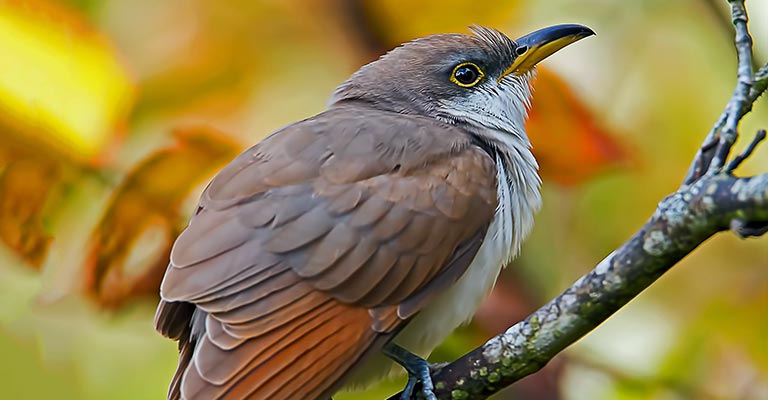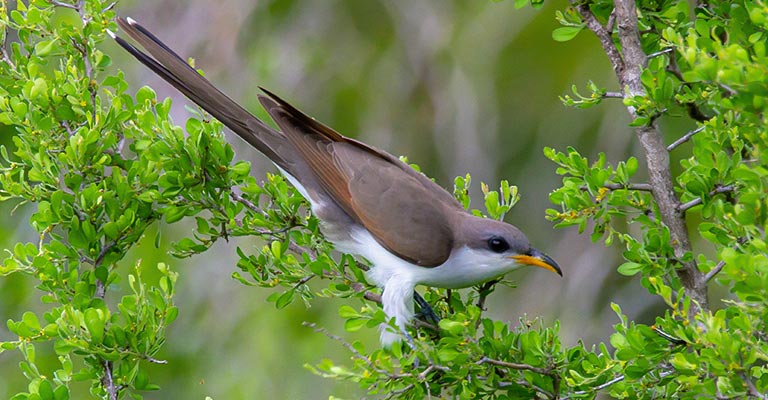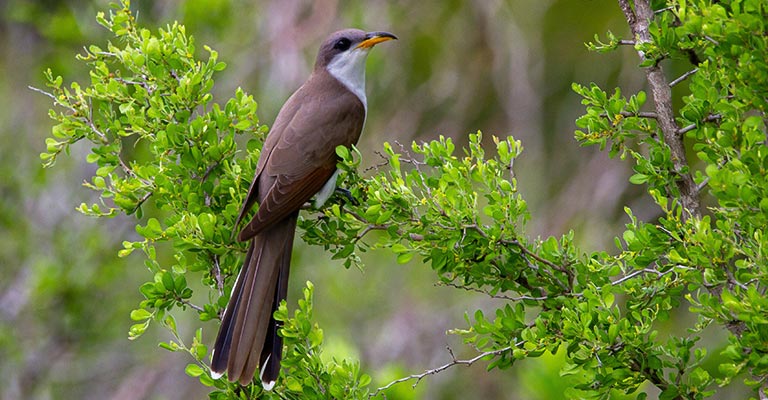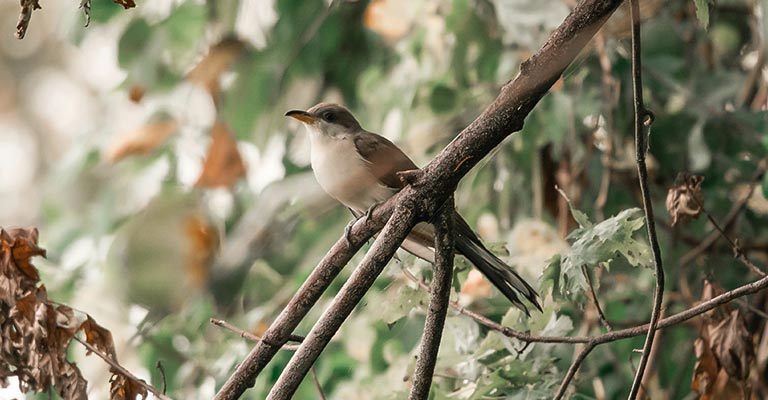The Yellow-billed Cuckoo (Coccyzus americanus) is a captivating bird species known for its distinctive appearance and behavior.
Native to North and Central America, this medium-sized cuckoo is recognized by its striking yellow lower mandible, a feature that sets it apart within its genus.
The Yellow-billed Cuckoo possesses an understated yet elegant aesthetic, sporting a predominantly brown plumage with white underparts and a long tail marked by bold white spots.
This elusive bird is renowned for its remarkable migratory journey, covering vast distances between its breeding grounds in North America and wintering grounds in South America.
Often associated with riparian habitats, the Yellow-billed Cuckoo is a skilled insect predator, relying on its agile flight and adept foraging techniques to capture prey.
Despite facing habitat loss and environmental challenges, the Yellow-billed Cuckoo remains a fascinating and ecologically significant species, captivating bird enthusiasts and conservationists alike.
Physical Characteristics of Yellow-billed Cuckoo

The Yellow-billed Cuckoo (Coccyzus americanus) possesses a unique physical characteristic that makes it easily distinguishable among bird species.
These features aid birdwatchers and ornithologists in identifying this elusive and captivating avian species.
Distinctive Bill Coloration
One of the most striking features of the Yellow-billed Cuckoo is its namesake – the bright yellow lower mandible.
This vibrant hue contrasts prominently against its overall brown plumage, creating a recognizable, arresting characteristic.
Subtle Plumage
The Yellow-billed Cuckoo exhibits a primarily brown plumage with a subtle combination of darker streaks on its upperparts.
The overall appearance is cryptic, providing effective camouflage in the dense vegetation of its favored habitats.
White Underparts
Contrasting with its earth-toned upperparts, the bird’s underparts are characterized by a clean, crisp white coloration.
This white ventral area extends from the throat down to the undertail cover, creating a distinct separation from the darker feathers above.
Long, Slender Body
The Yellow-billed Cuckoo boasts a slender and elongated body, contributing to its streamlined appearance during flight.
This physique is adapted for efficient aerial navigation and allows the bird to move swiftly through the dense vegetation it inhabits.
Prominent White Spots on the Tail
During the flight, the Yellow-billed Cuckoo reveals a striking pattern of bold white spots on its tail feathers. These spots create a visually arresting effect against the bird’s otherwise muted plumage, making it a distinctive sight in the sky.
Size and Shape
Measuring approximately 12 to 13 inches, the Yellow-billed Cuckoo falls within the medium-sized range for cuckoos. Its long tail and wings contribute to a distinctive silhouette, aiding in identification even from a distance.
Facial Markings
The facial features of the Yellow-billed Cuckoo include a distinctive white eyeline that extends from the base of the bill to the nape of the neck.
This eyeliner, combined with pale lore (the area between the eye and the bill), adds to the bird’s overall facial contrast.
Behavioral Clues
In addition to physical characteristics, the Yellow-billed Cuckoo’s behavior can aid in identification. It is often observed perched in a horizontal position, with its long tail adding to its overall length.
Its flight is characterized by a direct and rapid path through the vegetation, showcasing its agility and skill in navigating dense habitats.
The Yellow-billed Cuckoo’s distinctive yellow bill, subtle plumage, white underparts, slender body, tail spots, size, facial markings, and behavioral traits collectively contribute to its unique and easily identifiable profile in the avian world.
Bird enthusiasts and ornithologists can rely on these key characteristics to distinguish this remarkable species from its feathered counterparts.
Taxonomy of Yellow-billed Cuckoo

Here’s a table summarizing the taxonomy details of the Yellow-billed Cuckoo (Coccyzus americanus):
| Taxonomic Level | Classification |
| Domain | Eukaryota |
| Kingdom | Animalia |
| Phylum | Chordata |
| Class | Aves |
| Order | Cuculiformes |
| Family | Cuculidae |
| Genus | Coccyzus |
| Species | C. americanus |
The Yellow-billed Cuckoo (Coccyzus americanus) belongs to the family Cuculidae within the order Cuculiformes. Classified under the genus Coccyzus, this medium-sized cuckoo is characterized by its distinctive yellow lower mandible.
As part of the avian taxonomy, it is in the broader class Aves, encompassing all birds. Within the family Cuculidae, the Yellow-billed Cuckoo shares its kinship with various other cuckoo species.
Its binomial name, Coccyzus americanus, reflects its genus (Coccyzus) and species (americanus), emphasizing its connection to the diverse tapestry of avian life within the broader classification system.
Common Food of Yellow-billed Cuckoo

The Yellow-billed Cuckoo (Coccyzus americanus) exhibits a specialized diet of insects. With a keen ability to catch prey mid-air, this bird relies on its agile flight and adept foraging techniques.
Key components of the Yellow-billed Cuckoo’s diet include:
- Caterpillars: The cuckoo is particularly fond of caterpillars, showcasing a preference for these larvae in various stages of development.
- Insects in Flight: Known for its impressive aerial acrobatics, the Yellow-billed Cuckoo catches flying insects such as bees, wasps, and dragonflies.
- Beetles and Moths: Ground-dwelling insects like beetles and moths attracted to the vegetation in their habitat contribute significantly to the cuckoo’s diet.
- Spiders: Occasionally, the Yellow-billed Cuckoo supplements its diet with spiders, showcasing adaptability in its foraging strategies.
This specialized insectivorous diet aligns with the bird’s preferred habitats, often found in riparian areas and woodlands where insects are abundant, highlighting the ecological importance of the Yellow-billed Cuckoo in controlling insect populations.
Yellow-billed Cuckoo Life History
The Yellow-billed Cuckoo (Coccyzus americanus) is a captivating bird species with a rich life history that unfolds across diverse landscapes of North and Central America.
From its distinct appearance to migratory patterns and nesting behaviors, the life of the Yellow-billed Cuckoo is a testament to its adaptability and ecological significance.
Habitat
This cuckoo thrives in various habitats, favoring riparian zones, wooded areas, and forests with dense vegetation.
Its habitat choice aligns with the abundance of insects, providing an essential food source for the bird and emphasizing its ecological role in maintaining ecosystem balance.
Range Map
The Yellow-billed Cuckoo exhibits a vast range, from its breeding grounds in North America to its wintering areas in South America.
A range map showcases its migratory journey, highlighting key stopover points and illustrating the interconnectedness of ecosystems along its route.
Nesting
Nesting typically occurs in dense vegetation, where the Yellow-billed Cuckoo constructs a loose, twiggy platform for its nest.
The female lays a clutch of 2-4 eggs, and both parents contribute to incubation. The well-concealed nests protect from predators, reflecting the bird’s strategic approach to reproduction.
| Nesting Parameter | Details |
| Clutch Size | 2 to 4 eggs |
| Number of Broods | Usually 1 per breeding season |
| Egg Length | Approximately 1.2 to 1.5 inches (3.0 to 3.8 cm) |
| Egg Width | Approximately 0.9 to 1.1 inches (2.3 to 2.8 cm) |
| Incubation Period | About 11 to 14 days |
| Nestling Period | Around 10 to 11 days |
| Egg Description | Pale blue-green or bluish-white with no markings |
| Nest Construction | Loose, twiggy platform in dense vegetation |
| Incubation Responsibility | Shared by both male and female |
| Nest Concealment | Well-concealed within dense foliage |
| Parental Involvement | Both parents contribute to feeding and care |
| Nesting Habitat | Riparian zones, woodlands, and forests |
Breeding
Breeding season aligns with the warmer months, and the Yellow-billed Cuckoo engages in courtship displays characterized by vocalizations and aerial pursuits.
The pair bonds strengthen during this period, emphasizing the importance of mate selection and cooperation in the species’ reproductive success.
Diseases
While the Yellow-billed Cuckoo faces threats from habitat loss, there is also concern about diseases affecting bird populations.
Avian diseases, such as West Nile virus, pose risks to cuckoos, emphasizing the broader challenges of disease management in avian conservation.
Treatment
Efforts to address avian diseases involve monitoring and research to understand transmission patterns.
Conservationists and researchers work collaboratively to implement preventive measures, including habitat preservation, to mitigate disease risks and safeguard the health of the Yellow-billed Cuckoo population.
Conservation
The Yellow-billed Cuckoo faces conservation challenges due to habitat destruction and fragmentation.
Conservation efforts focus on preserving and restoring riparian habitats, implementing sustainable forestry practices, and raising awareness about the bird’s ecological importance.
Collaborative initiatives between government agencies, conservation organizations, and the public are essential to ensure the continued survival of this species.
The life history of the Yellow-billed Cuckoo is a fascinating narrative of adaptation, migration, reproduction, and conservation challenges.
Understanding and addressing the various facets of its life history are crucial steps in fostering the well-being of this remarkable bird species.
10 Fun Facts About Yellow-billed Cuckoo

The Yellow-billed Cuckoo (Coccyzus americanus) is a captivating avian species with a wealth of intriguing features that make it stand out in the birdwatching world.
From its distinctive appearance to unique behaviors, here are ten fun facts about the Yellow-billed Cuckoo that highlight its charm and ecological significance.
Migratory Marvel
Renowned for its impressive migratory journeys, the Yellow-billed Cuckoo covers astonishing distances between its breeding grounds in North America and wintering habitats in South America.
Yellow Mandible
The Yellow-billed Cuckoo derives its name from the striking yellow coloration of its lower mandible. This vibrant feature adds color to its overall earth-toned plumage, making it easily distinguishable in its habitat.
Insectivorous Appetite
As a dedicated insectivore, the Yellow-billed Cuckoo is vital in controlling insect populations.
Its preferred diet includes caterpillars, flying insects, beetles, moths, and spiders, showcasing a diverse palate within the insect world.
Expert Flycatcher
Known for its agile flight, the Yellow-billed Cuckoo is an expert at catching insects mid-air.
Its swift and direct flights through dense vegetation demonstrate remarkable aerial dexterity, contributing to its success as an insect predator.
White Tail Spots
The Yellow-billed Cuckoo unveils bold white spots on its tail feathers during flight. These distinctive markings add to its aesthetic appeal and serve as a visual cue for birdwatchers trying to spot this elusive species in the sky.
Cryptic Plumage
The bird’s cryptic brown plumage with subtle streaks on its upperparts provides effective camouflage in its preferred habitats. This adaptation helps it blend seamlessly with the foliage, enhancing its ability to ambush prey.
Nest Concealment
Regarding nesting, the Yellow-billed Cuckoo is a master of concealment. It constructs loose, twiggy platforms within dense vegetation, offering a well-hidden sanctuary for its eggs and nestlings.
Distinctive Vocalizations
The Yellow-billed Cuckoo is known for its unique vocalizations, including low, guttural “kow-kow-kow-kow” sounds. These calls are often heard during the breeding season, contributing to the auditory tapestry of its habitat.
Limited Brooding
Typically, the Yellow-billed Cuckoo raises only one brood per breeding season. This limited reproductive strategy aligns with the availability of its preferred food sources and the demands of its migratory lifestyle.
The Yellow-billed Cuckoo captivates bird enthusiasts with its vibrant features, remarkable behaviors, and crucial role in the intricate web of ecosystems it traverses.
Wrapping Up
The Yellow-billed Cuckoo emerges as a remarkable avian species, weaving together a narrative of resilience, adaptability, and ecological significance.
The cuckoo’s life history reflects a fascinating tapestry of survival strategies and conservation challenges, from its vibrant yellow bill to its skilled aerial maneuvers.
As we explore its migratory feats, nesting intricacies, and role in insect population control, the Yellow-billed Cuckoo stands as a symbol of the delicate balance within our ecosystems.
Conservation efforts are imperative to safeguard this species and ensure its continued contribution to the biodiversity of North and Central America.